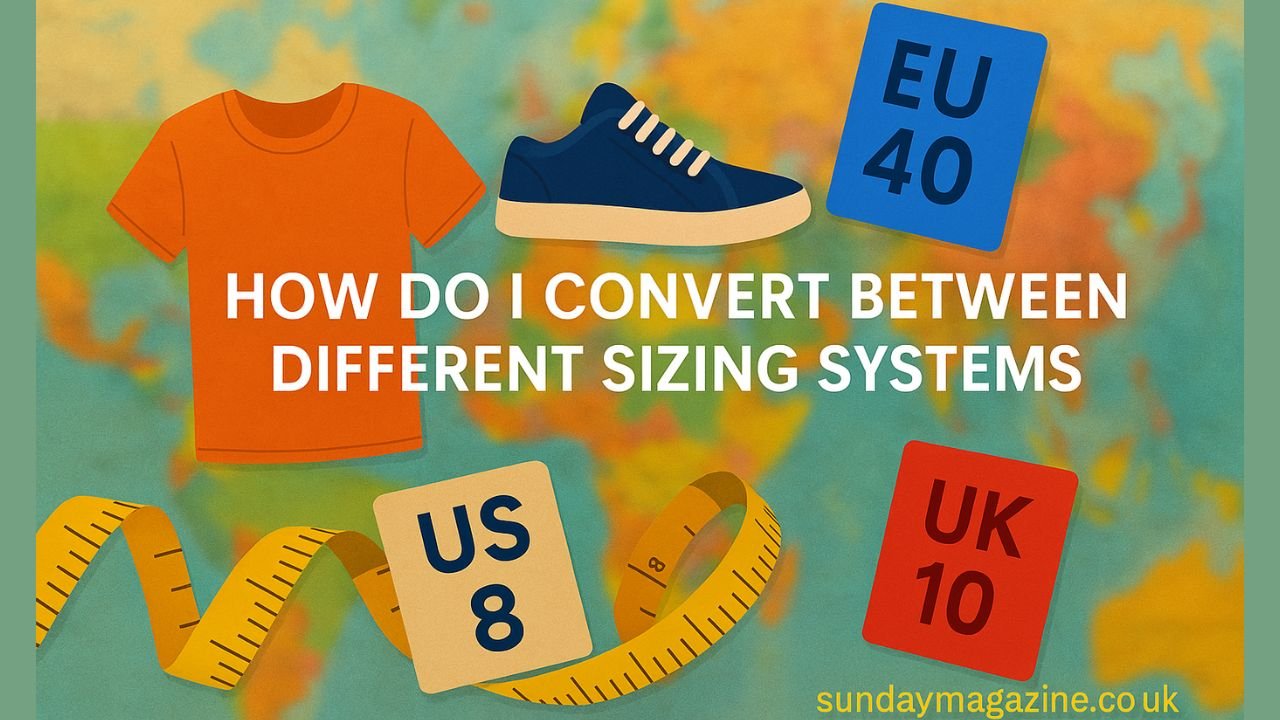When it comes to buying clothing, shoes, or even sporting equipment, understanding sizing systems can be a confusing and frustrating task. Different countries, industries, and even brands use various sizing systems, which can make the process of finding the right fit quite complicated. Whether you’re shopping for shoes from Europe, clothing from the U.S., or athletic gear from Asia, you’ll need to navigate these size variations. But how do you convert between these different sizing systems?
In this detailed article, we will answer the most common questions surrounding sizing systems, explore how to convert between them, and provide a comprehensive guide to help you make informed decisions. We will cover sizing systems for shoes, clothing, and more, while incorporating practical tips, helpful tools, and clear conversion methods.
ALSO READ: Kid Shoe Size Mexico to US Conversion
What Are Sizing Systems?
Sizing systems are standardized measurements used to categorize products such as clothing, shoes, and accessories based on their dimensions. These systems vary from country to country, and even from one industry to another. Sizing systems are used to ensure that products fit the average body dimensions of individuals within a specific region or market.
The Different Types of Sizing Systems
Sizing systems fall into three main categories:
- Numerical sizing: This is the most common form of sizing, where products are labeled with a number (e.g., size 8, 10, 12, etc.). This can vary by country and is often used in the fashion industry.
- Letter-based sizing: Many clothing items, especially in the U.S., use letter sizes such as XS, S, M, L, XL, and XXL to indicate fit.
- Measurement-based sizing: This is often used for shoes and some clothing items, where specific measurements (in inches or centimeters) are provided.
The key to understanding sizing systems is knowing how these numbers and letters correspond to body dimensions such as waist size, chest size, and inseam length, as well as foot measurements for shoes.
Common Sizing Systems by Region
Before diving into conversions, let’s look at some of the most widely used sizing systems around the world:
U.S. Sizing System
The U.S. sizing system is primarily numerical and letter-based. For clothing, sizes like Small (S), Medium (M), Large (L), and Extra Large (XL) are common for tops and dresses. Pants are often sized according to waist and inseam measurements (e.g., 32×32). Shoes in the U.S. are generally sized in numerical increments, such as 7, 8, 9, etc., and can differ slightly between men’s and women’s sizing.
UK Sizing System
The UK sizing system for clothing uses similar measurements to the U.S. system but with slight variations. For example, a UK size 10 is equivalent to a U.S. size 6. Shoe sizes in the UK are usually smaller than those in the U.S., with a UK size 7 being roughly a U.S. size 8.
European (EU) Sizing System
The European sizing system is commonly used for shoes and clothing in countries such as France, Germany, Italy, and Spain. Clothing sizes in the EU typically range from size 36 to 52 for women and 44 to 62 for men. EU shoe sizes are also numbered differently, with a European size 42 being equivalent to a U.S. men’s size 9.
Japanese Sizing System
Japan uses a unique sizing system for both clothing and shoes. For clothing, sizes tend to run smaller compared to U.S. or European standards. Shoe sizes in Japan are measured in centimeters, so a size 26 typically corresponds to a U.S. men’s size 8.
International Sizing for Shoes
Shoe sizes vary widely between regions, and this is one area where conversions are especially important. For instance, a European size 42 is approximately a U.S. men’s size 9 or a U.K. men’s size 8.5. Women’s shoe sizes also differ, with European sizes running larger than U.S. sizes.
How to Convert Between Sizing Systems
Now that we have an overview of the different sizing systems, let’s focus on how to convert between them. This will help you when you’re shopping online or traveling internationally, ensuring you pick the right size without the guesswork.
Converting Clothing Sizes
From U.S. to European
To convert between U.S. and European clothing sizes, here’s a basic guideline:
- Women’s U.S. Size 2 = EU Size 34
- Women’s U.S. Size 4 = EU Size 36
- Women’s U.S. Size 6 = EU Size 38
- Women’s U.S. Size 8 = EU Size 40
For men’s clothing, the conversion is a bit more straightforward:
- Men’s U.S. Size 34 = EU Size 44
- Men’s U.S. Size 36 = EU Size 46
From U.S. to U.K.
The U.K. sizing system is generally smaller than the U.S. system. To convert U.S. clothing sizes to U.K. sizes, subtract 2 sizes:
- U.S. Size 6 = U.K. Size 10
- U.S. Size 8 = U.K. Size 12
- U.S. Size 10 = U.K. Size 14
From U.K. to European
Converting from U.K. sizes to European sizes involves adding 30 to the U.K. size for women’s clothing:
- U.K. Size 8 = EU Size 38
- U.K. Size 10 = EU Size 40
- U.K. Size 12 = EU Size 42
For men’s clothing, the conversion is typically more straightforward.
Converting Shoe Sizes
Converting shoe sizes can be tricky, especially since different countries have different standards for measuring foot length. Let’s break down the process for various regions:
U.S. to European Shoe Size Conversion
Here’s a simple U.S. to European shoe size conversion chart for both men’s and women’s sizes:
| U.S. Men’s | U.K. Men’s | EU Men’s | U.S. Women’s | U.K. Women’s | EU Women’s |
|---|---|---|---|---|---|
| 6 | 5 | 39 | 7 | 5.5 | 37 |
| 7 | 6 | 40 | 8 | 6.5 | 38 |
| 8 | 7 | 41 | 9 | 7.5 | 39 |
| 9 | 8 | 42 | 10 | 8.5 | 40 |
U.S. to Japanese Shoe Size Conversion
Japanese shoe sizes are measured in centimeters. To convert U.S. shoe sizes to Japanese sizes, add approximately 16 to the U.S. men’s size or 17 to the U.S. women’s size:
- U.S. Men’s 8 = Japanese Size 26
- U.S. Women’s 6 = Japanese Size 24
Tools for Easy Size Conversion
There are several online tools that can help make these conversions easier:
- Size Conversion Charts: Many websites provide detailed conversion charts for different regions and product types.
- Shoe Size Converters: Websites like Zappos and Amazon have built-in shoe size converters that automatically convert sizes between countries.
- Clothing Size Calculators: Websites such as SizeCharter offer interactive tools where you can input your measurements and find the equivalent size in various international systems.
Conclusion
Understanding and converting between different sizing systems is essential for finding the right fit when shopping internationally. By learning how to convert between U.S., European, U.K., and Japanese sizes, you can shop with confidence, whether you’re buying clothes or shoes from abroad.
Remember that sizing systems can vary from brand to brand, so always refer to specific size charts when possible. Additionally, tools like size converters and detailed charts are great resources to ensure you’re selecting the correct size.
Frequently Asked Questions (FAQs)
1. What is the difference between U.S. and European sizing?
The main difference lies in the numbering system and how the measurements are calculated. U.S. sizes tend to be larger than European sizes. For example, a U.S. size 8 is typically a European size 38.
2. How do I know my true size in different systems?
The best way to determine your size is to take accurate measurements of your body (chest, waist, hips, and inseam) and compare them with size charts provided by manufacturers or retailers.
3. Do all brands follow the same sizing standards?
No, sizing can vary significantly from one brand to another, even within the same country. Always check size charts specific to the brand before making a purchase.
4. How do I convert shoe sizes between U.S., U.K., and EU?
Shoe sizes are measured differently in various regions. The best way to convert between these systems is to use a shoe size conversion chart or an online calculator.





